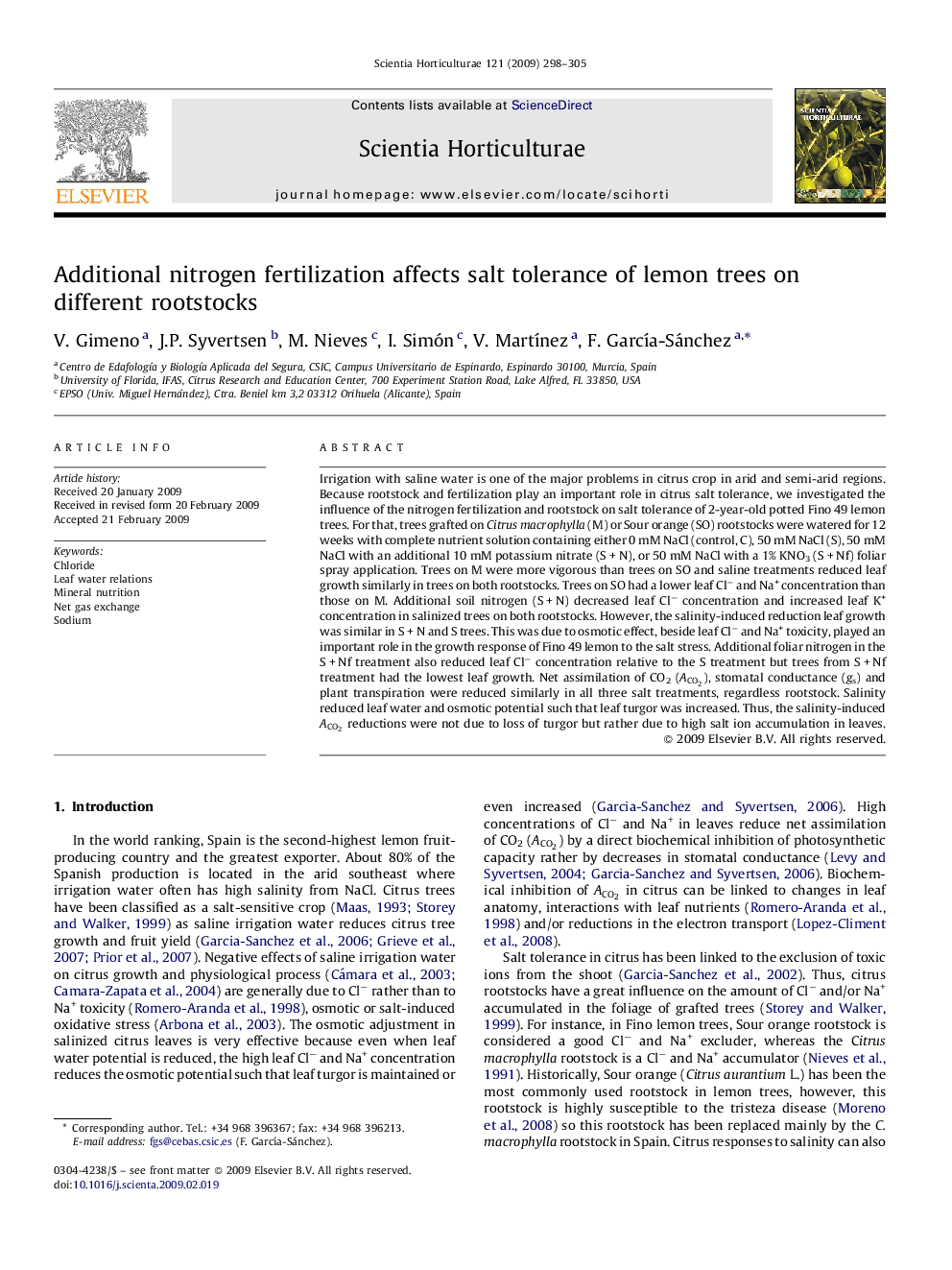| کد مقاله | کد نشریه | سال انتشار | مقاله انگلیسی | نسخه تمام متن |
|---|---|---|---|---|
| 4569107 | 1331324 | 2009 | 8 صفحه PDF | دانلود رایگان |
عنوان انگلیسی مقاله ISI
Additional nitrogen fertilization affects salt tolerance of lemon trees on different rootstocks
دانلود مقاله + سفارش ترجمه
دانلود مقاله ISI انگلیسی
رایگان برای ایرانیان
کلمات کلیدی
موضوعات مرتبط
علوم زیستی و بیوفناوری
علوم کشاورزی و بیولوژیک
دانش باغداری
پیش نمایش صفحه اول مقاله

چکیده انگلیسی
Irrigation with saline water is one of the major problems in citrus crop in arid and semi-arid regions. Because rootstock and fertilization play an important role in citrus salt tolerance, we investigated the influence of the nitrogen fertilization and rootstock on salt tolerance of 2-year-old potted Fino 49 lemon trees. For that, trees grafted on Citrus macrophylla (M) or Sour orange (SO) rootstocks were watered for 12 weeks with complete nutrient solution containing either 0Â mM NaCl (control, C), 50Â mM NaCl (S), 50Â mM NaCl with an additional 10Â mM potassium nitrate (SÂ +Â N), or 50Â mM NaCl with a 1% KNO3 (SÂ +Â Nf) foliar spray application. Trees on M were more vigorous than trees on SO and saline treatments reduced leaf growth similarly in trees on both rootstocks. Trees on SO had a lower leaf Clâ and Na+ concentration than those on M. Additional soil nitrogen (SÂ +Â N) decreased leaf Clâ concentration and increased leaf K+ concentration in salinized trees on both rootstocks. However, the salinity-induced reduction leaf growth was similar in SÂ +Â N and S trees. This was due to osmotic effect, beside leaf Clâ and Na+ toxicity, played an important role in the growth response of Fino 49 lemon to the salt stress. Additional foliar nitrogen in the SÂ +Â Nf treatment also reduced leaf Clâ concentration relative to the S treatment but trees from SÂ +Â Nf treatment had the lowest leaf growth. Net assimilation of CO2 (ACO2), stomatal conductance (gs) and plant transpiration were reduced similarly in all three salt treatments, regardless rootstock. Salinity reduced leaf water and osmotic potential such that leaf turgor was increased. Thus, the salinity-induced ACO2 reductions were not due to loss of turgor but rather due to high salt ion accumulation in leaves.
ناشر
Database: Elsevier - ScienceDirect (ساینس دایرکت)
Journal: Scientia Horticulturae - Volume 121, Issue 3, 2 July 2009, Pages 298-305
Journal: Scientia Horticulturae - Volume 121, Issue 3, 2 July 2009, Pages 298-305
نویسندگان
V. Gimeno, J.P. Syvertsen, M. Nieves, I. Simón, V. MartÃnez, F. GarcÃa-Sánchez,